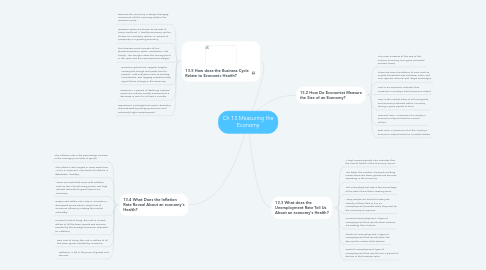Ch 13 Measuring the Economy
by Sarah Fiske

1. 13.4 What Does the Inflation Rate Reveal About an economy's Health?
1.1. The inflation rate is the percentage increase in the average price level of goods.
1.2. The inflation rate ranged in 2000-2008 from -.04 to 3.8 percent. Low levels of inflation is debatable "healthy"
1.3. There are costs that come with inflation such as loss of purchasing power and high interest rates which great impact our economy.
1.4. Buyers and sellers can't rely on increase or decreased prices which causes loss of economic efficiency making the market unhealthy.
1.5. Nominal Cost of living: the cost in current dollars of all the basic goods and services needed by the average consumer (adjusted for inflation)
1.6. Real cost of living: the cost in dollars of all the basic goods needed by consumer
1.7. Deflation: a fall in the price of goods and services
2. 13.5 How does the Business Cycle Relate to Economic Health?
2.1. Because the economy is always changing, economist call the recurring pattern the Business Cycle.
2.2. Business cycles are known as periods of boom and bust. A healthy economy can be known as a recovery, upturn, or period of prosperity in a growing economy.
2.3. The business cycle consists of four phases:expansion, peak, contraction, and trough. The trough makes the turning point in the cycle and the new expansion begins.
2.4. Business cycles have irregular lengths causing the trough and peaks hard to predict. With indicators such as leading, coincidental, and lagging indicators help signal future change in the economy.
2.5. Recession: a period of declining national economic activity, usually measured as a decrease in GDP for at least 6 months.
2.6. Depression: prolonged economic downturn characterized by plunging real GDP and extremely high unemployment
3. 13.2 How Do Economist Measure the Size of an Economy?
3.1. The main measure of the size of the nation's economy is its gross Domestic product (GDP)
3.2. There are some limitations of GDP such as unpaid household and volunteer work, and GDP ignores informal and illegal exchanges.
3.3. GDP is an economic indicator that measures a country's total economic output
3.4. GDP is the market value of all final goods and services produced within a country during a given period of time.
3.5. Nominal GDP: a measure of a country's economic output valued in current dollars
3.6. Real GDP: a measures of of the country's economic output valued in constant dollars
4. 13.3 What does the Unemployment Rate Tell Us About an economy's Health?
4.1. A high unemployment rate indicates that the overall health of the economy is poor.
4.2. The fewer the number of people working means there are fewer goods and services operating in the economy.
4.3. The unemployment rate is the percentage of the labor force that is seeking work.
4.4. Many people are forced to take jobs outside of their filed or live on unemployment benefits while they wait for the economy to improve.
4.5. Frictional unemployment: a type of unemployment that results when workers are seeking their first job
4.6. Structural Unemployment: a type of unemployment that results when the demand for certain skills decline.
4.7. Cyclical unemployment: type of unemployment that results from a period of decline in the business cycle


